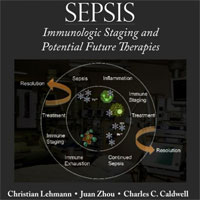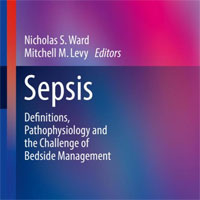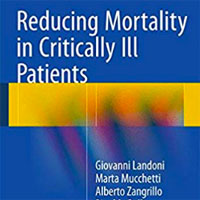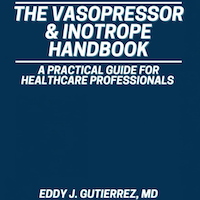Tag: lactate
Epinephrine Challenge in Sepsis: An Empiric Approach to Catecholamines
The critical care world is obsessed with fluid. Meanwhile, little attention has been given to the concepts of vasopressor responsiveness and vasopressor challenge. This is a missed opportunity, because vasopressor challenges... read more
Serum Lactate Level and Mortality in Metformin-associated Lactic Acidosis Requiring RRT
This study suggests that predialysis level of serum lactate level is an important marker of mortality in MALA patients requiring renal replacement therapy (RRT) with a linear dose-response relationship. To better evaluate... read more
Lactate and Stepwise Lactate Kinetics Used to Guide Resuscitation
Lactate is an important parameter for monitoring tissue perfusion at present. Lactate kinetics are particularly important to evaluate the response of ICU patients. Therefore, lactate can be the starting point for resuscitation,... read more
Optimizing Therapy of Bloodstream Infection Due to Extended-spectrum β-lactamase-producing Enterobacteriaceae
Carbapenems should be used in patients with serious infections; alternatives could be used individually, particularly for definitive treatment of patients with milder presentations. Meropenem and imipenem are the drugs... read more
Assessment of Microcirculation in Cardiogenic Shock
The parameter most frequently used to detect tissue malperfusion is serum lactate. Novel, noninvasive methods to quantify microvascular perfusion have the potential to guide treatment in terms of optimizing organ perfusion... read more
Risk Factors Associated with 30-day Mortality for Out-of-Center ECMO Support
Out-of-hospital extracorporeal membrane oxygenation (ECMO) implantation and ECMO transport have become a growing field useful for emergent treatment of heart or lung failure with increasing number of centers launching such... read more
Early Goal-directed Therapy Using a Physiological Holistic View
If peripheral perfusion-targeted resuscitation improves 28-day mortality, this could lead to simplified algorithms, assessing almost in real-time the reperfusion process, and pursuing more physiologically sound objectives.... read more
Sex-specific Differences in Survival After Out-of-hospital Cardiac Arrest
This nationwide, population-based observational study in Japan included 386,535 adult patients aged ≥ 18 years with out-of-hospital cardiac arrest (OHCA). In all these patients, resuscitation was attempted by EMS personnel... read more
Terlipressin for Septic Shock Patients
Catecholamines are commonly used in septic shock but face limitations of their hypo-responsiveness and adverse events due to high dose. Terlipressin is a synthetic vasopressin analog with greater selectivity for the V1-receptor.... read more
Ideas for Future Intensive Care
Progress toward determining the true worth of ongoing practices or value of recent innovations can be glacially slow when we insist on following the conventional stepwise scientific pathway. Moreover, a widely accepted but... read more
Minimizing Catecholamines and Optimizing Perfusion
The main goal of hemodynamic resuscitation in shock is to improve tissue perfusion and oxygenation. As these cannot be directly evaluated at bedside in routine practice, physicians are left with surrogates such as perfusion... read more
Measuring Lactate vs. Capillary Refill in Guiding Resuscitation in Shock
Capillary refill is as least as good as measuring lactate in guiding resuscitation efforts in septic shock. Moreover, using a lactate-driven resuscitation strategy led to use of more pressors and more IV fluid administration... read more
Excited Delirium: Acute Management in the ED Setting
Excited delirium syndrome is a common yet poorly characterized ED presentation with a wide differential diagnosis. Patients are often identified initially by law enforcement, but attempts to control individuals experiencing... read more
Relationship of at Admission Lactate, Unmeasured Anions, and Chloride to the Outcome of Critically Ill Patients
Four thousand nine hundred one patients were admitted throughout the study period; 1,609 met criteria for metabolic acidosis and 145 had normal acid-base values. The association between at admission lactate, unmeasured anions,... read more
Lactate-Guided Resuscitation Only Encourages Over-Resuscitation and Downstream Harms
The Centers for Medicare and Medicaid Services and the Surviving Sepsis Campaign both rushed to offer guidance on the appropriate management strategies for patients presenting with septic shock. In both cases, a lactate-guided... read more
Prognostic Accuracy of the Serum Lactate Level, the SOFA Score and the qSOFA Score for Mortality Among Adults with Sepsis
Sepsis is a common critical condition caused by the body’s overwhelming response to certain infective agents. Many biomarkers, including the serum lactate level, have been used for sepsis diagnosis and guiding treatment.... read more
Loss of Sphingosine 1-Phosphate in Septic Shock is Predominantly Caused by Decreased Levels of HDL
Sphingosine 1-phosphate (S1P) is a signaling lipid essential in regulating processes involved in sepsis pathophysiology, including endothelial permeability and vascular tone. Serum S1P is progressively reduced in sepsis patients... read more
Sepsis and Septic Shock – What Matters from EM Cases Course
In this podcast Dr. Sara Gray, intensivist and emergency physician, co-author of The CAEP Sepsis Guidelines, answers questions such as: How does one best recognize occult septic shock? How does SIRS, qSOFA and NEWS compare... read more
Effect of a Resuscitation Strategy Targeting Peripheral Perfusion Status vs Serum Lactate Levels on 28-Day Mortality Among Patients With Septic Shock
Among patients with septic shock, a resuscitation strategy targeting normalization of capillary refill time, compared with a strategy targeting serum lactate levels, did not reduce all-cause 28-day mortality. Among 424 patients... read more
Should We Stop Trending Lactate in Septic Shock?
There may be a tendency to cement guideline recommendations into our collective minds as inalienable and sacrosanct – as if carved onto stone tablets and brought down to us from the heights of Mount Sinai. Thoughtful medicine,... read more
Effect of Thiamine Administration on Lactate Clearance and Mortality in Patients With Septic Shock
Thiamine administration within 24 hours of admission in patients presenting with septic shock was associated with improved lactate clearance and a reduction in 28-day mortality compared with matched controls. Patients who... read more
Early Lactate Measurements Appear to Improve Results for Septic Patients
The study by Churpek and colleagues was designed to evaluate both the frequency of urgent lactate measurements and their association with clinician interventions and mortality. An elevated lactate level means that a patient's... read more









